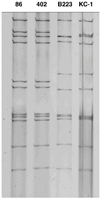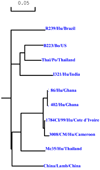The global spread of rotavirus G10 strains: Detection in Ghanaian children hospitalized with diarrhea
- PMID: 20684709
- PMCID: PMC2954461
- DOI: 10.1086/653572
The global spread of rotavirus G10 strains: Detection in Ghanaian children hospitalized with diarrhea
Abstract
From October 2003 through September 2004, a total of 289 stool samples were collected from children <5 years of age who had severe diarrhea at admission to or when visiting the emergency department at the Navrongo War Memorial Hospital in rural Ghana during a study on rotavirus disease burden. Rotavirus antigen was detected in 115 stool samples (39.8%) tested for rotavirus. Four rotavirus-positive samples were found to bear G10P[6] specificity by reverse-transcription polymerase chain reaction, polymerase chain reaction-enzyme-linked immunosorbent assay, and oligonucleotide microarray hybridization. Two of these strains further exhibited serotype G10 specificity by neutralization and subgroup II specificity by enzyme immunoassay and possessed long electropheretic patterns by polyacrylamide gel electrophoresis. Their VP7 genes shared a much closer nucleotide identity with other African human G10 strains (>97%) than with human G10 strain from Asia or South America (<86%) or animal strains (<85%). The VP8* genes of the Ghanaian G10 strains exhibited >94% identity to that of human P[6] virus strains and belonged to the P[6] lineage 1a. The deduced VP7 amino acid sequence showed that the Ghanaian strains were more closely related to human G10 strains than to animal G10 strains. The possession of the typical human subgroup II specificity and the P[6] specificity (frequently found in Ghana and the rest of Africa) and the marked similarity in the VP7 antigenic sites suggest that these G10 strains may have evolved through genetic reassortment between bovine and human strains.
Figures



References
-
- Black RE, Morris SS, Bryce J. Where and why are 10 million children dying every year? Lancet. 2003;361:2226–2234. - PubMed
-
- Estes M. Rotavirus and their replication. In: Knipe DM, Howley PM, Griffin DE, Lamb RA, Martin MA, Roizman B, Struss SE, editors. Fields Virology. 4th edition. Philadelphia: Lippincott, William and Wilkins Press; 2001. pp. 1747–1785.
-
- Kapikian AZ, Hoshino Y, Chanock RM. Rotaviruses. In: Knipe DM, Howley PM, Griffin DE, Lamb RA, Martin MA, Roizman B, Struss SE, editors. Fields Virology. 4th edition. Philadelphia: Lippincott, William and Wilkins Press; 2001. pp. 1787–1793.
Publication types
MeSH terms
Substances
Associated data
- Actions
- Actions
- Actions
- Actions
Grants and funding
LinkOut - more resources
Full Text Sources
Medical

